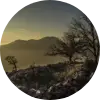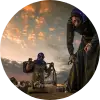
















Hazreti Süleyman Mosque
General Information: Hazreti Süleyman Mosque is a historical mosque located in the Sur district of Diyarbakır, Turkey. It is also known as Kale Mosque, Nasiriyye Mosque, Meşhed Mosque, or Murtaza Pasha Mosque. Built by the Inaloğulları Principality, this mosque is renowned for containing tombs believed to belong to 27 companions of the Prophet Muhammad. The mosque bears traces of both the Inaloğulları and Ottoman periods.
History: From inscriptions on its minaret, it is understood that the mosque was built in 1160 during the reign of Nisanoğlu Kemaleddin Ebu'l Kasım Ali (1156-1179) of the Inaloğulları Principality. During the Ottoman period, it was expanded for the first time and endowed with a waqf by Sultan Süleyman the Magnificent. It underwent renovations during the tenure of Silahtar Murtaza Pasha, who served as the governor of Diyarbekir Province during the reign of Sultan Murad IV (1631-1633). Various extensions were made to the mosque mainly during the second half of the 19th century and the first quarter of the 20th century. The mosque has undergone restoration in the years 1960-61, 1974-77, and 2004.
Architecture: The mosque complex is situated between two towers of the Inner Castle walls of Diyarbakır, on sloping terrain. The complex includes the mosque itself, a tomb and cemetery attached to the west of the mosque, a courtyard, a prayer area used in summer months located to the right of the western entrance gate, ablution areas with porticoes to the left, and a second tomb section to the north of the mosque.
The mosque, with a square minaret, is constructed from black cut basalt stone. Entry to the mosque is through two gates from the south and west, and a fountain with twelve spouts is located against the north wall of the mosque courtyard. Adjacent to the west wall of the mosque is a section containing the tomb graves of Hazrat Suleiman, the son of the famous Arab commander Khalid ibn Walid, and other companions who died during the Arab conquest of the city.
The tomb, connected to the first and second parts of the prayer area by separate doors, is square in plan. While Ottoman tiles adorn the walls of the mosque, the prayer area is elevated from the courtyard by a row of stone steps. The ablution area is covered with four domes with pendantives, and its walls are constructed from black basalt stone. The mosque has a rectangular plan and the second tomb, portico, and southern side graves are not original but date from the 17th century and later.
There are a total of twelve inscriptions on the mosque, including construction and renovation inscriptions. An inscription on the eastern face of the minaret contains the construction inscription. The inscriptions are surrounded by a half-round groove and a flat belt on three sides.